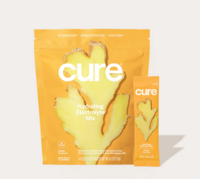If you have endometriosis, you probably already know this, but according to the most recent research, 50 to 70% of people with endometriosis report dyspareunia, or pelvic pain that occurs before, during, or after penetrative vaginal sex. Pain with sex for endometriosis patients has also been so normalized that the overall medical community hasn’t done much to treat it — it’s just expected, and has even been taboo to discuss in endometriosis patient circles.
For Jacqueline Solivan, Director of Partnerships at Rescripted and endometriosis warrior, “Painful sex has no limits or restrictions — it honestly almost always hurts.” She describes it like the pain you feel when pushing on a bruise, and that it can be unpredictable in its timing with the rest of your cycle and endometriosis flare-ups.
Here, we dig deeper into the causes of endometriosis pain with sex, treatment options and workarounds, and how to begin the conversation about painful sex with your partner.
Why does endometriosis cause pain with sex?
Because endometriosis is a condition in which tissue that’s similar to that of the uterine lining grows outside the uterus (on the colon, pelvic floor, and bladder), that tissue can cause extra inflammation as it grows where it doesn’t belong, explains Lyndsey Harper, MD, FACOG, CEO and founder of Rosy, a sexual and reproductive health app that recently launched a “Quickies” education feature that can answer all your questions about everything from migraines to endometriosis. Pain with sex can arise from the inflammation of the muscles of the pelvic floor, causing tightness and tension. Instead of those muscles relaxing for activities like sex and peeing, the pelvic floor muscles stay tight, according to Dr. Harper.
And because your body and mind are not really separate entities when it comes to sex, trying to be sexually active during an endometriosis flare might essentially “teach” your body that sex equals pain. “Your body and mind remember ‘this hurts…’ and that can increase the pain experience and become a cyclical problem,” says Dr. Harper. It can be difficult to disassociate pain and sex, so you may benefit from mental as well as physical support.
Are there any treatment options that help?
Every person’s experience with dyspareunia is different, but here are some techniques that might help with painful sex.
Pelvic floor physical therapy
There’s not a magic bullet “cure” for endometriosis, but pelvic floor physical therapy can be an effective treatment, according to Marcy Crouch, PT, DPT, board-certified pelvic floor therapist and creator of The Down There Doc. “It can help with the muscle tension, weakness, or dysfunction that develops in the pelvic floor muscles due to the pain,” says Dr. Crouch. It may sound intimidating, but pelvic floor PTs are trained to do manual therapy in a trauma-informed way with explicit consent from patients. They can also help you work on stretches, exercises, and relaxation techniques for pelvic floor muscle function and reduce pain, she adds.
Home exercises and stretches
“Between pelvic floor PT sessions, a physical therapist will ask you to practice relaxation techniques such as diaphragmatic breathing and mindfulness exercises to manage pain and reduce muscle tension,” Dr. Crouch says. Your PT will also give you “homework” exercises that will be customized to you and will help you practice strengthening, lengthening, and relaxing the pelvic floor muscles at home.
Some other pain management techniques include applying heating pads to your pelvic area, says Dr. Crouch. You can also keep up with a regular gentle yoga or stretching routine to keep the muscles both strong and as relaxed as possible, she adds. A healthy diet, adequate hydration, and stress management (which could look like meditation, counseling, neither, or both) is all part of the pelvic pain picture, too.
Sex therapy or other mental mental health support
Pain with sex is so wrapped up in blame, shame, and embarrassment, Dr. Harper says. Dyspareunia is no one’s “fault,” and it’s important to have open conversations about it. A sex therapist, for example, can help you navigate those discussions by giving you sample scripts to articulate the pain and your comfort level with sex to a physician, a partner, or whomever needs to listen, suggests Dr. Harper. You can even bring a partner into that therapy experience.
Getting creative with lube and positions
Sex is not supposed to be painful for any party involved. For some people, adding a lube can ensure comfort with movement, especially one that provides a warming sensation, like K-Y Yours and Mine Couples Lubricant, says Shan Boodram, certified sexologist and K-Y’s sex and relationship expert.
Additionally, Solivan recommends experimenting with your partner to find go-to positions that ease pain and discomfort. For instance, to control the depth and speed of penetration, you can try getting on top of your partner and adjusting the angles from there, according to the Cleveland Clinic.
How to communicate with a partner about painful sex
If you are working with a sex therapist or counselor, something to work on is holding space for all of your feelings, including disappointment that sex is not what you want it to be. “It has taken a toll on me emotionally for sure, and feels like part of my womanhood has been ripped from me,” Solivan says. “I want sex to be fun, enjoyable, and consistent because I deserve that. I feel like if anything is taboo it’s that.” The pain should not be considered as normal as it is.
It’s no secret that sex is all about communication. “Before sex begins, couples should lay out what they want and don’t want (e.g. pain) and spend quality time gushing about why they want each other to help increase that desire for one another,” Boodram advises. It’s important that both partners are committed to ensuring safety and prioritizing intimacy first. “This can help set the playing field and increase the emotional connection before the physical connection takes place,” she adds.
One other thing your partner can do to participate is their research on endometriosis, on painful sex, and on helping you with pain. “There’s nothing sexier or more comforting than knowing that you are not expected to carry both the pain and the planning of managing the pain, alone,” according to Boodram.
Mara Santilli is a journalist reporting on health and wellness and how social and political systems influence the well-being of certain groups, including but not limited to Black and brown communities, women, and the LGBTQ+ community. Her editorial work has appeared in publications such as Shape, Marie Claire, Cosmopolitan, Women’s Health, InStyle, Glamour, and more. Outside of reading and writing, she enjoys traveling (especially to Italy), singing, dancing, musical theatre, and playing guitar and piano.

.jpg)
















